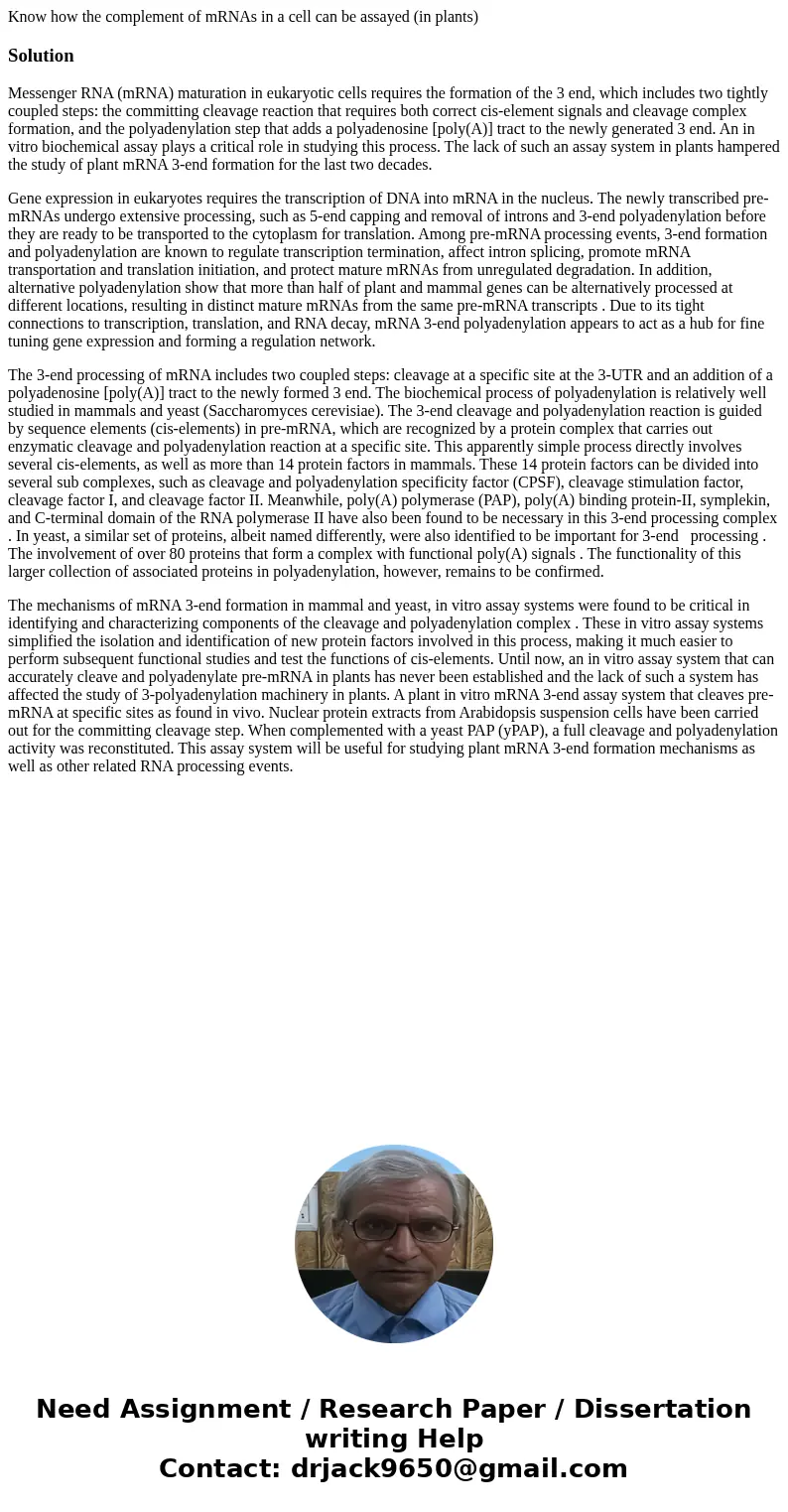Know how the complement of mRNAs in a cell can be assayed in
Know how the complement of mRNAs in a cell can be assayed (in plants)
Solution
Messenger RNA (mRNA) maturation in eukaryotic cells requires the formation of the 3 end, which includes two tightly coupled steps: the committing cleavage reaction that requires both correct cis-element signals and cleavage complex formation, and the polyadenylation step that adds a polyadenosine [poly(A)] tract to the newly generated 3 end. An in vitro biochemical assay plays a critical role in studying this process. The lack of such an assay system in plants hampered the study of plant mRNA 3-end formation for the last two decades.
Gene expression in eukaryotes requires the transcription of DNA into mRNA in the nucleus. The newly transcribed pre-mRNAs undergo extensive processing, such as 5-end capping and removal of introns and 3-end polyadenylation before they are ready to be transported to the cytoplasm for translation. Among pre-mRNA processing events, 3-end formation and polyadenylation are known to regulate transcription termination, affect intron splicing, promote mRNA transportation and translation initiation, and protect mature mRNAs from unregulated degradation. In addition, alternative polyadenylation show that more than half of plant and mammal genes can be alternatively processed at different locations, resulting in distinct mature mRNAs from the same pre-mRNA transcripts . Due to its tight connections to transcription, translation, and RNA decay, mRNA 3-end polyadenylation appears to act as a hub for fine tuning gene expression and forming a regulation network.
The 3-end processing of mRNA includes two coupled steps: cleavage at a specific site at the 3-UTR and an addition of a polyadenosine [poly(A)] tract to the newly formed 3 end. The biochemical process of polyadenylation is relatively well studied in mammals and yeast (Saccharomyces cerevisiae). The 3-end cleavage and polyadenylation reaction is guided by sequence elements (cis-elements) in pre-mRNA, which are recognized by a protein complex that carries out enzymatic cleavage and polyadenylation reaction at a specific site. This apparently simple process directly involves several cis-elements, as well as more than 14 protein factors in mammals. These 14 protein factors can be divided into several sub complexes, such as cleavage and polyadenylation specificity factor (CPSF), cleavage stimulation factor, cleavage factor I, and cleavage factor II. Meanwhile, poly(A) polymerase (PAP), poly(A) binding protein-II, symplekin, and C-terminal domain of the RNA polymerase II have also been found to be necessary in this 3-end processing complex . In yeast, a similar set of proteins, albeit named differently, were also identified to be important for 3-end processing . The involvement of over 80 proteins that form a complex with functional poly(A) signals . The functionality of this larger collection of associated proteins in polyadenylation, however, remains to be confirmed.
The mechanisms of mRNA 3-end formation in mammal and yeast, in vitro assay systems were found to be critical in identifying and characterizing components of the cleavage and polyadenylation complex . These in vitro assay systems simplified the isolation and identification of new protein factors involved in this process, making it much easier to perform subsequent functional studies and test the functions of cis-elements. Until now, an in vitro assay system that can accurately cleave and polyadenylate pre-mRNA in plants has never been established and the lack of such a system has affected the study of 3-polyadenylation machinery in plants. A plant in vitro mRNA 3-end assay system that cleaves pre-mRNA at specific sites as found in vivo. Nuclear protein extracts from Arabidopsis suspension cells have been carried out for the committing cleavage step. When complemented with a yeast PAP (yPAP), a full cleavage and polyadenylation activity was reconstituted. This assay system will be useful for studying plant mRNA 3-end formation mechanisms as well as other related RNA processing events.

 Homework Sourse
Homework Sourse